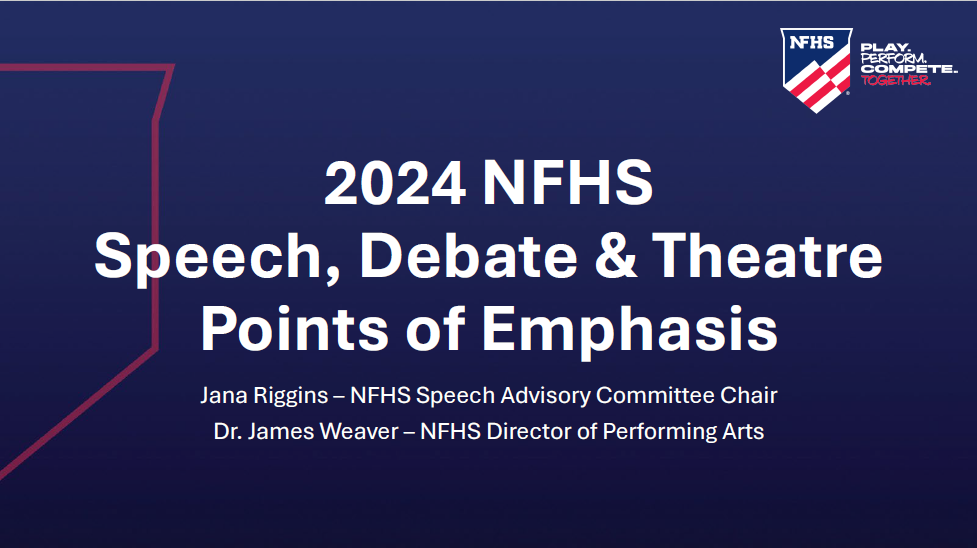Artificial Intelligence (AI) Integration in High School Speech and Debate
By NFHS on February 23, 2024 Speech Debate & Theatre Directors PrintPotential positive impacts of President Biden's Executive Order on AI on high school speech and debate programs could be multifaceted:
- Enhanced AI Tools: The emphasis on AI safety and innovation could lead to the development of more advanced AI tools for research and argumentation analysis, aiding students in preparing and refining their debate strategies.
- AI Literacy and Training: Investment in AI education could result in incorporating AI literacy into speech and debate curricula, helping students understand and critically analyze the role and influence of AI in public discourse.
- Equity and Inclusivity: With the focus on equity and civil rights, speech and debate programs may integrate AI tools designed to reduce bias and promote inclusivity, thereby promoting fair and diverse perspectives in debates.
- Data Privacy and Protection: The importance placed on privacy and civil liberties in the EO suggests that any AI tools used in speech and debate must adhere to strict data protection standards, safeguarding students' personal information.
- Global Perspectives: The EO’s encouragement of global collaboration could allow students to engage with and debate global issues thereby helping students understand and articulate their positions on issues of global importance.
Overall, the Executive Order may lead to a more sophisticated, equitable, and globally informed speech and debate educational environment at the high school level.
Potential negative impacts of the Executive Order on AI in high school speech and debate programs might include:
- Resource Disparity: Schools with limited resources may struggle to access or implement advanced AI tools, potentially widening the gap between well-funded and underfunded programs.
- Overreliance on AI: There's a risk that an overemphasis on AI tools could overshadow traditional research and critical thinking skills essential in speech and debate.
- Privacy Concerns: Despite the focus on privacy and data protection, the use of AI in educational settings could raise concerns about student data security and consent.
- Complexity and Misunderstanding: The complexity of AI technologies might lead to misunderstandings or misinterpretations of AI-generated information, potentially impacting the quality of debate content. It is important that all information from AI-generated content be researched independently.
- Bias Erroneous Information and Discrimination: Despite efforts to promote equity, AI systems can inadvertently perpetuate biases, influence debate topics or arguments in a skewed manner.
These concerns highlight the need for careful implementation and continuous evaluation of AI use in educational settings.
Policy Guidance for State Associations: Utilizing AI in High School Speech and Debate Programs
Reference: President Biden's Executive Order on AI
Purpose: To guide state associations in the responsible integration of AI technologies into high school speech and debate programs, through aligning with the principles set forth in the Executive Order on AI.
Key Principles:
- Safe and Responsible AI Use: Ensure AI tools used in programs are safe, secure, and comply with federal standards. Prioritize tools that enhance educational value while minimizing risks.
- Equity and Inclusivity: AI applications should promote fairness and inclusivity. Avoid tools that perpetuate bias or discrimination and strive for diverse perspectives in speech and debate content.
- AI Literacy and Education: Incorporate AI literacy into speech and debate curricula to help students understand AI's role in information analysis and public discourse.
- Privacy Protection: Strictly adhere to student data privacy laws. Ensure AI tools comply with privacy and data protection standards, and maintaining confidentiality and integrity of student information.
- Resource Accessibility: Address disparities in AI tool access. Provide support to underfunded programs to ensure equitable opportunities for all students.
- Critical Thinking Emphasis: While utilizing AI for research and preparation, maintain the importance of traditional research methods and critical thinking skills.
- Global and Ethical Perspectives: Encourage debate topics that reflect global issues and ethical considerations in AI, fostering a broader understanding of AI’s impact on society.
Implementation and Monitoring: State associations should provide training for educators on effectively integrating AI into speech and debate programs. States should also provide direction on monitoring the usage of AI tools in adherence to state adopted guidelines. Regular feedback and evaluation should be conducted to continually refine AI integration in line with evolving technology and educational needs.
Conclusion: By adhering to these principles, state associations can harness the potential of AI in enhancing the educational experience of high school speech and debate programs, while upholding the principles of safety, equity, and responsible innovation.




